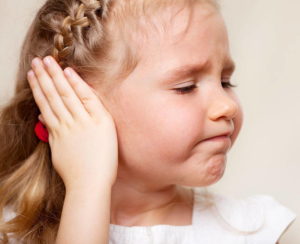
Most ear infections are caused by viruses, and not bacteria. Ear infections are fairly common, and account for 15 million to 30 million visits to the doctor each year in the United States.
 A majority of children will have had an ear infection by the time they reach 3 years old. About one third of children have at least three episodes of ear infections before turning 3.
A majority of children will have had an ear infection by the time they reach 3 years old. About one third of children have at least three episodes of ear infections before turning 3.
With that in mind, what are the ear infection symptoms that signal it is time for panic? How serious is your infection? Are the painful symptoms pointing to an ear infection, or is it something else?
What is an ear infection?
There are many types of ear infections. Both occur whenever bacteria or a virus affects part of the ear. The result is inflammation in the ear, and it can happen in the outer, middle or inner parts of the ear. And while there are several different types of ear infections, the two most common are middle ear and inner infection.
Middle ear infection is commonly known as acute otitis media. Middle ear infections affect children, and include swimmer’s ear. Inner ear infections are much rarer, and they are referred by doctors as vestibular neuritis. Inner ear infections inflame the inner ear and the nerves connecting the inner ear with the brain.
Many people ask whether ear infections are contagious. In most cases, these infections are not contagious. However, in some bacterial cases, they can be. For example, if you develop swimmer’s ear from swimming in a contaminated water, the conclusion is that the bacteria itself is contagious.
Why should you worry?
While ear infections are relatively harmless, they can cause some long-term complications in rare cases. That happens if the infection is left untreated, and progresses for more than two weeks. In this case, a treatment from a doctor is a must. Here are some complications that can occur due to ear infections:
– Hearing complications in severe cases, as the infection causes the mucous membrane to swell up and secrete fluid for long period of time
– Speech delays and other developmental language challenges, if the child is not treated to overcome the ear infection
– Mastoidits, a bacterial infection of the membranes lining the mastoid bone. This is a bone in the skull located close to the ear, and if left untreated, the infection can result in permanent damage
– Meningitis, another infection which can cause nerve damage, high fever, and pain
What are the symptoms of ear infection?
Symptoms usually include earaches and/or throbbing pain. With that in mind, here is the full list of symptoms of ear infections:
- Earaches and ear pain, feeling like throbbing pain or pulsing in the ears
- Trouble sleeping due to pain
- Fever symptoms, and in children the fever can become high
- Red and inflamed eardrum
- Itchiness in the ear
- Pain around the ears, radiating down the neck
- Crying, head shaking, and rubbing in children due to pain
- Signs of head cold
- Fluid leaking from the ears
- Sensory changes, including hearing changes, dizziness, nausea, vertigo, and loss of balance
How to tell the difference between ear infection and earache?
People commonly mistake earache for an ear infection. Here is how you can tell the difference.
Earaches occur when pressure mounts near the eardrum due to fluid retention from respiratory illness. In most cases, that is the common cold or flu. Earache symptoms are less severe than ear infections, and go away once the cold goes away.
Symptoms of ear infection include fluid leaking from the ear, inflammation when you look into the ear canal, redness, hearing changes, and difficulty sleeping. All of these symptoms are not present in earaches.
Most importantly, ear aches go away on their own, while an ear infection requires treatment.

Be the first to comment